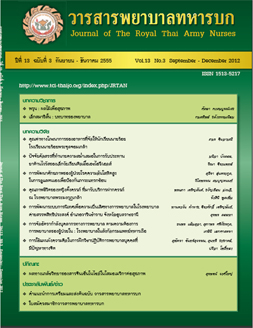การพัฒนาศักยภาพของผู้ป่วยโรคความดันโลหิตสูง(Developing self-care competency to prevent complication in hypertensive clients in the community)
Keywords:
การพัฒนาศักยภาพ, ผู้ป่วยโรคความดันโลหิตสูง, การวิจัยเชิงปฏิบัติการ, Developing self-care competency, hypertensive clients, action researchAbstract
บทคัดย่อ
การวิจัยนี้มีวัตถุประสงค์ ต้องการหาอัตราความชุกของโรค (Prevalence rate) ของโรคความดันโลหิตสูงในชุมชน ศึกษาปัจจัยต่างๆที่มีผลต่อการเกิดภาวะแทรกซ้อนของโรค และประเมินผลโครงการการให้ความรู้เพื่อปรับเปลี่ยนพฤติกรรมของผู้ป่วย ใช้วิธีการวิจัยเชิงปฎิบัติการ โดยการสำรวจวัดความดันโลหิตประชาชนที่มีอายุ 30 ปีขึ้นไปในชุมชนแห่งหนึ่ง เขตบางกอกน้อย กทม. จำนวน 239 คน สัมภาษณ์โดยใช้แบบสอบถามและสังเกตพฤติกรรมการดูแลตนเองในผู้ป่วยโรคความดันโลหิตสูงและดำเนินโครงการให้ความรู้เพื่อปรับเปลี่ยนพฤติกรรมรวม 6 ครั้ง เดือนละครั้ง จำนวน 50 คน
ผลการศึกษาพบว่า อัตราความชุกของโรค = 33.89(81/239) ประชาชนที่มีพฤติกรรมเสี่ยง 54 คน(classified from JNC 2003) ปัจจัยที่มีผลต่อการเกิดภาวะแทรกซ้อน ได้แก่ พฤติกรรมการกิน รับประทานอาหารเค็ม (เกือบทุกมื้อและมากกว่า 3 ครั้งในสัปดาห์) ร้อยละ 61.73 (50/81)
รับประทานอาหารที่มีไขมันสูงร้อยละ 18.53 (15/81) พฤติกรรมไม่ออกกำลังกาย ร้อยละ 96.30 (78/81) ขาดการรักษาอย่างต่อเนื่อง ร้อยละ 61.73 (50/81) BMI เกินมาตรฐานร้อยละ 37.04(30/81) และBMI อยู่ในเกณฑ์โรคอ้วน ร้อยละ14.81(12/81) ผลจากการดำเนินโครงการฯ ในผู้ป่วยจำนวน 50 คน พบว่าผู้ป่วยทั้ง 50 คน ไม่มีภาวะแทรกซ้อนเพิ่มขึ้นจากเดิม ร้อยละ 100และสามารถควบคุมระดับความดันโลหิตให้อยู่ในระดับที่น้อยกว่า 130/80 mmHg ร้อยละ 60(30/50) ความรู้เกี่ยวกับการดูแลตนเองเพิ่มขึ้นร้อยละ 100 (X Pretest =7.5 X Posttest=9) พฤติกรรมการดูแลตนเองมีการปรับเปลี่ยนในทางที่ดีขึ้นเกือบทั้งหมด อยู่ระหว่างร้อยละ 50-60 ยกเว้นการออกกำลังกายที่ดีขึ้นเพียงร้อยละ 20 (10/50)เท่านั้น จะเห็นได้ว่าการดำเนินโครงการการให้ความรู้ ประสพผลสำเร็จในการปรับเปลี่ยนพฤติกรรมการดูแลตนเองของผู้ป่วยฯได้เป็นอย่างดี
คำสำคัญ: การพัฒนาศักยภาพ; ผู้ป่วยโรคความดันโลหิตสูง; การวิจัยเชิงปฏิบัติการ
Abstract
This research was aimed to 1) seek out the prevalence of hypertension and its contributing factors and 2) to evaluate the educational program for lifestyle modification among hypertensive patients. Action research was used by surveying blood pressure among the total sample of 239 adults aged 30 and over living in the community in Bangkok Noi district, Bangkok. They were interviewed and observed self care behavior of hypertensive patients. The lifestyle modification educational program was implemented once a month for six months in 50 hypertensive clients. The results showed that the prevalence rate of hypertension was 33.89 (81/239). Fifty-four persons were at risk of hypertension (classified from JNC, 2003). Factors associated with hypertensive complication were eating behavior; consuming salty diet in almost every meal and more than 3 times a week (61.73%, 50/81); consuming high fat diet (18.53%, 15/81); physical inactivity (96.30%, 78/81), lacking of treatment follow up (61.73%, 50/81); over standard BMI (37.04%, 30/81); and overweight (14.81%, 12/81).
The lifestyle modification educational program for 50 patients showed no hypertensive complication (100%). All of the 50 participants were be able to control their blood pressure at lower than 130/80 mmHg (60%, 30/50) and developed the knowledge in self-care management of hypertension (100%, X Pretest = 7.5 and X Posttest = 9). Self-care behavior of the clients were improved after the program ( 50 -60%) except for exercise behavior which was improved for only 20% (10/50).
In conclusion, the lifestyle modification educational program to prevent the complication of hypertension had shown the most effectiveness in improving self-care competency among hypertensive clients.
Keywords: Developing self-care competency; hypertensive clients; action research
Downloads
Downloads
Published
How to Cite
Issue
Section
License
บทความหรือข้อคิดเห็นใดใดที่ปรากฏในวารสารพยาบาลทหารบกเป็นวรรณกรรมของผู้เขียน ซึ่งบรรณาธิการหรือสมาคมพยาบาลทหารบก ไม่จำเป็นต้องเห็นด้วย
บทความที่ได้รับการตีพิมพ์เป็นลิขสิทธิ์ของวารสารพยาบาลทหารบก
The ideas and opinions expressed in the Journal of The Royal Thai Army Nurses are those of the authors and not necessarily those
of the editor or Royal Thai Army Nurses Association.






